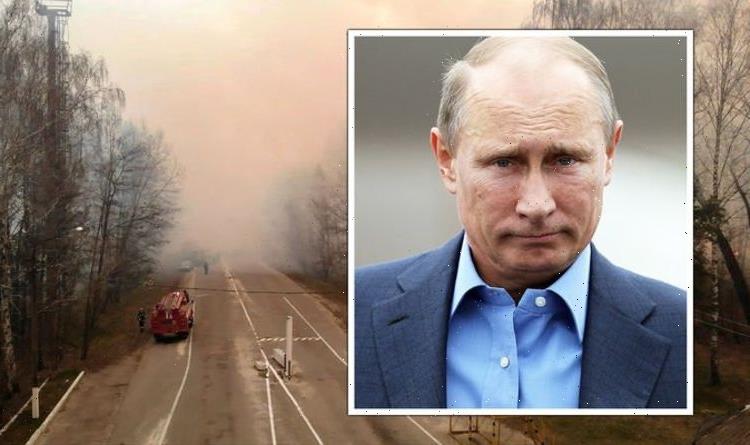Biden says Putin will pay ‘dear price’ if he invades Ukraine
We use your sign-up to provide content in ways you’ve consented to and to improve our understanding of you. This may include adverts from us and 3rd parties based on our understanding. You can unsubscribe at any time. More info
With reports that around 100,000 Russian troops are stationed at the Russia-Ukraine border, the world appears to be holding its breath as an attack could be launched at any minute. But one route into Ukraine’s capital, Kiev, that the Russians may take runs through is one of the most radioactive areas on the planet. Back in 1986, a nuclear accident at the Chernobyl Nuclear Power Plant led to several explosions at the site, which sent the levels of radiation soaring in the area.
To this day, a 2,600 km2 exclusion zone exists to protect people from radiation exposure.
The town where the zone exists, Prypyat, was evacuated. It was once home to around 50,000 residents.
While the Chernobyl Exclusion Zone is still a restricted area, the radiation is in the ground and is sinking deeper year by year.
But tourists can enter the zone if they go in with a licenced guide.
Many areas within the zone are still considered especially dangerous.


Exposure to radiation comes with serious risks like mutations in DNA and an increased risk of thyroid cancer.
But the exclusion zone is not too far Kiev, and just five kilometres to the north is the border with Belarus, Russia’s ally.
And in southern Belarus, tens of thousands of Russian soldiers have reportedly been massing.
The Russian defence ministry has also said it sent two battalions of S-400 missile systems, fighter jets and a Pantsir missile system.
US President Joe Biden told reporters Russian troops were “along the entire Belarus border”.

Now, there have been reports that the Ukrainian army has been taking weapons as well as equipment to detect radiation in the area.
Lieutenant Colonel Yuri Shakhraichuk, a Ukrainian border guard, told The New York Times: “It doesn’t matter if it is contaminated or nobody lives here.
“It is our territory, our country, and we must defend it.”
As this route may be the quickest way Russian soldiers can siege the capital, it is perhaps no surprise that Ukrainian troops are readying themselves here.
The soldiers are reportedly patrolling the streets with Kalashnikov rifles ready to send any warning signs back to Kiev.
DON’T MISS
Putin furious as Germany BANS Russian gas and signs deal with Ukraine [REPORT]
Wuhan scientists warn new ‘NeoCov’ virus found in bats [REVEAL]
EU blows top at Brexit Britain as it demands access to UK energy [INSIGHT]

And while the area had been mostly abandoned following the nuclear reactor meltdown, some workers still live there to keep safety apparatus in place.
Oleksei Prishepa, a worker in the area, told The New York Times: “We don’t know what will kill us first, the virus, radiation or war.
“It’s wasteland. No crop will ever grow here.”
But Russia may not want to put its troops as risk, especially considering the threats that have been issued by the West.
Mr Biden has warned Vladimir Putin there will be “severe “ consequences if Russia invades.
One proposed measure involves SWIFT payment system.

SWIFT, is the Society for Worldwide Interbank Financial Telecommunication.
The global electronic payments system is used by over 11,000 financial institutions and is vital for global finance.
If Russia is banned, as the US and the UK are reportedly eyeing up, most financial institutions would not be able to send money into or out of the country.
This has been referred to as the “nuclear” option in terms of sanctions, which would “cripple” the Russian economy.
Brandon Weichert, founder of The Weichert Report: An Online Journal of Geopolitics, told Express.co.uk: “The move would devastate the Russian economy and risk regime stability. So, at that point, all bets are off.”
Source: Read Full Article
